Recently, Professor Xiaodong Wang and Professor Yao Shen from Shanghai Jiao Tong University explore a phase-specific tailoring strategy for high strength and synergetic, prolonged work hardening in dual- or multi-phase systems, using a duplex stainless steel (DSS) composed of ferrite and austenite phases as a model material. The research article, “Phase-specific tailoring strategy for synergetic and prolonged work hardening to achieve superior strength-plasticity in lamellar-structured alloy” was published in the internationally renowned academic journal International Journal of Plasticity (Publication link:https://doi.org/10.1016/j.ijplas.2025.104317).
Prof. Xiaodong Wang and Prof. Yao Shen are the corresponding authors of the article. Zhang Yumeng, a PhD student at Shanghai Jiao Tong University, is the first author. The research work has been supported by the National Natural Science Foundation of China (No. 52171010, 52071210, 51821001) and the Project of ShangHai Gas Turbine Union Innovation Center (2024 Sci. &Tech.02-5).
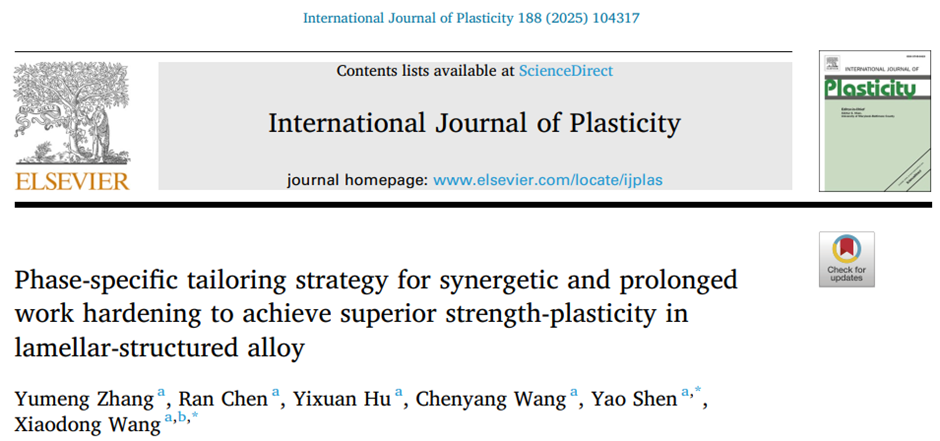
The research team has long focused on the development of high-strength stainless steel, achieving a series of scientific advances. These include studies on the deformation behavior of AlN precipitates in the steel matrix and their interaction with the matrix (International Journal of Plasticity, 2023, 166: 103631) and the development of a duplex stainless steel with bimodal structure along with the proposal of its underlying strengthening mechanism (Acta Materialia, 2022, 226: 117670). Building on their previous work, the research team recently further tailored the microstructure of the duplex stainless steel. Based on the characteristics and deformation mechanisms of different phases, they designed a phase-specific strategy for high strength and synergetic, prolonged work hardening. This research presents a promising microstructural design strategy for enhancing the plasticity of dual- and multi-phase systems with high-strength.
The pursuit of alloys that integrate high strength and substantial plasticity persists across various industries. Nevertheless, alloys engineered for elevated strength commonly manifest unsustainable work hardening, ultimately leading to a decline in plasticity. This issue is particularly pronounced in high-strength body-centered cubic (BCC) alloys, whose uniform elongations are typically on the order of 10%, primarily due to dislocation activity being the sole deformation mechanism. Prolonging the work hardening under high stress levels is key to bypassing the traditional design limitations. Dual- or even multi-phase systems offer vast potential for novel microstructural engineering aimed at harmonizing these inversely related property requirements.
Using a duplex stainless steel (composed of austenite and ferrite phases) as the research vehicle, the research team proposed a “phase-specific tailoring” strategy. Through a simple and feasible two-step cold rolling combined with incomplete annealing process, they constructed an alternating austenite-ferrite lamellae structure. By utilizing XRD, nanoindentation, EBSD, TEM characterization at different strains, and finite element simulation, they analyzed the work hardening mechanisms within each phase and the synergetic effects between phases during deformation.
The core of this strategy lies in achieving initial high strength and prolonged work hardening of the two phases through phase-specific microstructure design and lamellar thickness control. Specifically, the significantly enhanced yield strength originates from pre-existing defects, numerous lamella interfaces, and quasi iso-strain deformation mode. The excellent plasticity benefits from the synergetic hardening components achieving more uniform strain distribution over a wide strain range. The study found that the sustained hardening in austenite is achieved by the shifting of hardening mechanism from being dominated by dislocation activity to being dominated by TRIP effect. Martensite laths in favorable configurations with retained austenite in between, contributed to the improved ductility of hardened austenite lamellae. The wide-range work hardening of BCC-structured ferrite was realized by the extended range of effective dislocation activities through lowering initial dislocation density and increasing peak density during deformation. The latter is realized by reducing the thickness of ferrite lamellae, which limited the space for dislocation motions and self-organization, suppressing dislocation cells development in ferrite.
This innovative strategy enables the HLS to achieve a yield strength (~900 MPa) nearly twice the yield strength of its conventional counterpart while maintaining an excellent total elongation of 45%. This study establishes a universally applicable strategy framework that can potentially be extended to other dual- or multi-phase alloys, opening up a new avenue for enhancing the plasticity of high-strength alloys.
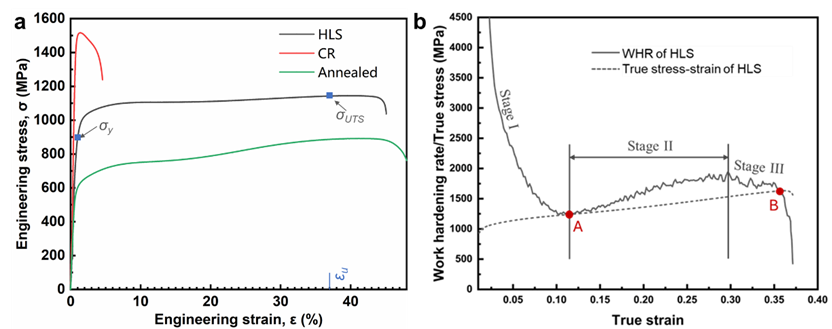
Tensile properties of the developed HLS DSS.
(a) Representative engineering stress-strain curves of Annealed, CR and HLS. (b) The work-hardening and true stress-strain curves of HLS.

The heterogeneous microstructure of the developed HLS.
(a) Representative EBSD phase maps showing various sections of HLS (green color represents ferrite; blue color represents austenite). (b) The GND density map of the RD-ND plane of (a). (c) A comparison of GND density distributions in the ferrite and austenite.

Micro-hardness evolution of HLS.
(a) Changes in micro-hardness of HLS as a whole during deformation. (b) The individual hardness evolution of the austenite and ferrite phases, respectively.
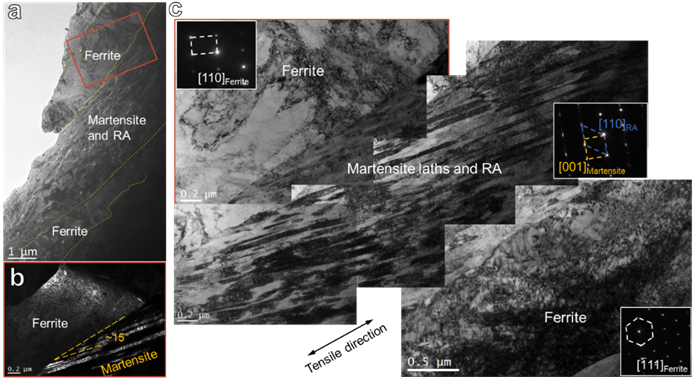
Deformed microstructure of the RD-ND plane of HLS.
(a) The deformation-induced martensite and RA adjacent to two ferrite lamellae at low magnification. (b) Dark-field TEM image of the area marked with red rectangle in (a), showing the ferrite and martensite laths which are inclined at ~15° to the RD. (c) The bright-field TEM overview image of the RD-ND plane showing the lamella, consisting of RA and martensite laths, sandwiched by two ferrite lamellae. Insets are corresponding selected area electron diffraction (SAED) patterns.
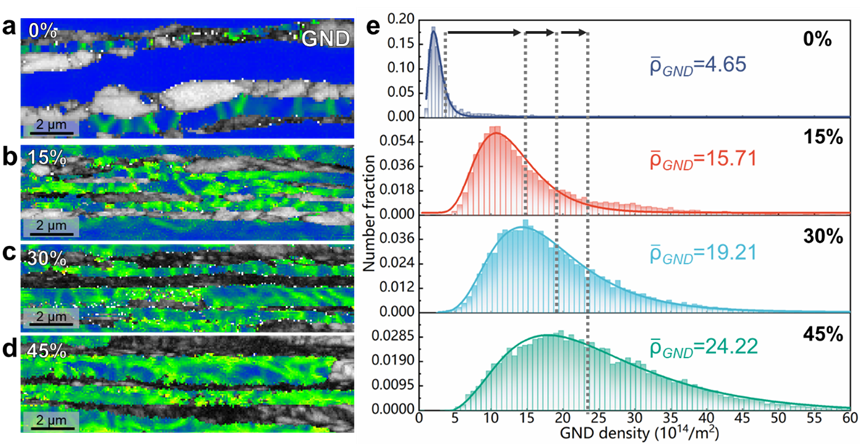
Detailed EBSD analyses on the ferrite microstructures at various strain levels.
(a-d) GND maps of ferrite show the dislocation distribution variation at 0%, 15%, 30% and 45% engineering strain during deformation. (e) Statistical distribution on the GND density calculated based on GND maps.
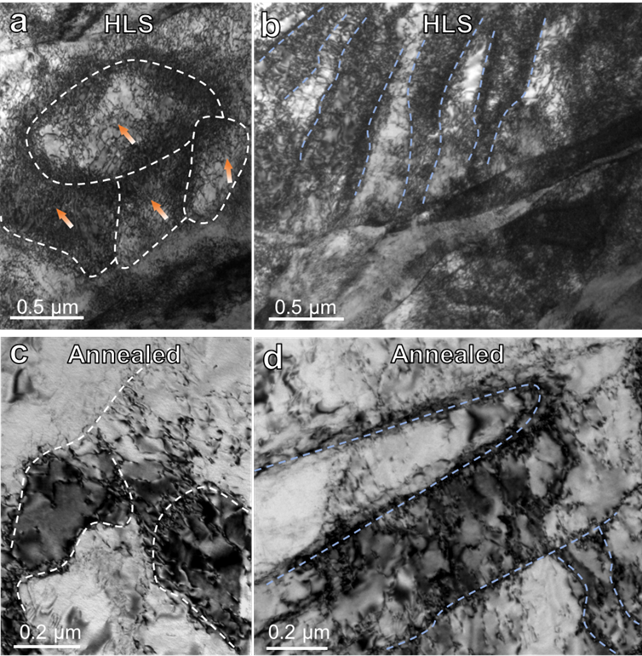
Dislocation configuration in ferrite of HLS and annealed samples.
(a-b) Dislocation cells and bands indicated by dashed lines in the ferrite lamellae of HLS at 45% engineering strain. (c-d) Dislocation substructures in the ferrite with near-equiaxed grains of annealed sample at 45% engineering strain.
